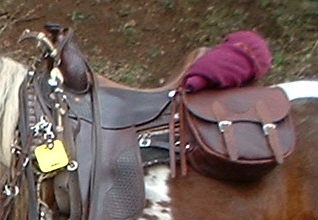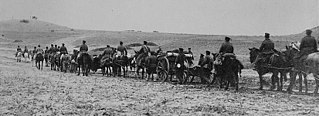This article concerns systems of transport in Lesotho. As a landlocked country, Lesotho has no seaports or harbours, but does have road, air transport, and limited rail infrastructure.

The mule is a domestic equine hybrid between a donkey and a horse. It is the offspring of a male donkey and a female horse. The horse and the donkey are different species, with different numbers of chromosomes; of the two possible first-generation hybrids between them, the mule is easier to obtain and more common than the hinny, which is the offspring of a female donkey and a male horse.

The California Trail was an emigrant trail of about 1,600 mi (2,600 km) across the western half of the North American continent from Missouri River towns to what is now the state of California. After it was established, the first half of the California Trail followed the same corridor of networked river valley trails as the Oregon Trail and the Mormon Trail, namely the valleys of the Platte, North Platte, and Sweetwater rivers to Wyoming. The trail has several splits and cutoffs for alternative routes around major landforms and to different destinations, with a combined length of over 5,000 mi (8,000 km).

A pack animal, also known as a sumpter animal or beast of burden, is an individual or type of working animal used by humans as means of transporting materials by attaching them so their weight bears on the animal's back, in contrast to draft animals which pull loads but do not carry them.

A crupper is a piece of tack used on horses and other equids to keep a saddle, harness or other equipment from sliding forward.

Saddlebags are bags that are attached to saddles.

The Marlow branch line is a single track railway line in England, between Maidenhead station in Berkshire and Bourne End and Marlow stations in Buckinghamshire. It is 7 miles 10 chains (11.5 km) in length. Passenger services are operated by Great Western Railway using Class 165 and Class 166 diesel trains. The line connects to the Great Western Main Line at Maidenhead; it uses a section of the former Wycombe Railway line to High Wycombe together with the former Great Marlow Railway.

A pack saddle is any device designed to be secured on the back of a horse, mule, or other working animal so it can carry heavy loads such as luggage, firewood, small cannons, or other things too heavy to be carried by humans.

Lehigh Gorge State Park is a 4,548 acres (1,841 ha) Pennsylvania state park in Luzerne and Carbon Counties, Pennsylvania. The park encompasses a gorge, which stretches along the Lehigh River from a U.S. Army Corps of Engineers flood control dam in Luzerne County to Jim Thorpe in Carbon County. The primary recreational activity at Lehigh Gorge State Park is white water rafting.

Mounted search and rescue (MSAR) is a specialty within search and rescue (SAR), using horses as search partners and for transportation to search for missing persons. SAR responders on horseback are primarily a search resource, but also can provide off-road logistics support and transportation. Mounted SAR responders can in some terrains move faster on the ground than a human on foot, can transport more equipment, and may be physically less exhausted than a SAR responder performing the same task on foot. Mounted SAR responders typically have longer initial response times than groundpounder SAR resources, due to the time required to pick up trailer, horse(s), and perhaps also water, feed, and equipment.
A pack station is the base of operations for transporting freight via pack animals in areas that do not allow for other forms of transportation, either due to difficult access or use restrictions as defined in Wilderness Act. The station facilitates the transition from mechanized transportation to pack animals, and necessarily includes a corral for the animals and sometimes a stock loading ramp. In some places there may also be a barn or other structure to house feed and tack, and a loading dock or shelter for the items to be transported. In locations on private land, there may be a business office on site.

The Bicentennial National Trail (BNT), originally known as the National Horse Trail, is one of the longest multi-use, non-motorised, self-reliant trails in the world, stretching 5,330 kilometres from Cooktown, Queensland, through New South Wales and the Australian Capital Territory to Healesville, 60 km north-east of Melbourne. This trail runs the length of the rugged Great Dividing Range through national parks, private property and alongside wilderness areas. The BNT follows old coach roads, stock routes, brumby tracks, rivers and fire trails. It was originally intended for horses, but is these days promoted also for cycling and walking, though it is not yet entirely suited to these two activities.

Breeching ( "britching") is a strap around the haunches of a draft, pack or riding animal. Both under saddle and in harness, breeching engages when an animal slows down or travels downhill and is used to brake or stabilize a load.

In military contexts, a train is the logistical transport elements accompanying a military force. Often called a supply train or baggage train, it has the job of providing materiel for their associated combat forces when in the field. When focused on provision of field artillery and its ammunition, it may be termed an artillery train. For sieges, the addition of siege engines to an artillery train was called a siege train. These military terms predate, and do not imply a railway train, though railways are often employed for modern logistics, and can include armoured trains.

The Montana Trail was a wagon road that served gold rush towns such as Bannack, Virginia City and later Helena during the Montana gold rush era of the 1860s and 1870s. Miners and settlers all traveled the trail to try to find better lives in Montana. The trail was also utilized for freighting and shipping supplies and food goods to Montana from Utah. American Indians, as well as the weather, were major risks to traveling on the Montana Trail.

Kura (鞍), is the generic name for the Japanese saddle. The word "kura" is most commonly associated with the saddle used by the samurai class of feudal Japan. Over time the Japanese added elements of their own until the Japanese saddle became an identifiable style, also known as the samurai saddle.
The Susquehanna and Tioga Turnpike; also called the Berwick and Tioga Turnpike, and Susquehanna & Tioga Turnpike connecting via the high ground of tributary valleys Berwick and upstream, Tioga—chartered & incorporated in 1806, the toll road, like many middle ages toll roads in Europe was opened initially as an animal power turnpike in Northeastern Pennsylvania connecting early Central and Northern Eastern Pennsylvania along the Main Branch Susquehanna River to Lower New York State. Established in the early American canal age, and undercapitalized, it took several years to gradually extend improved trails in stages 100 miles (160 km) to Elmira, New York from its southern terminus at Berwick, Pennsylvania opposite Nescopeck across the Susquehanna River—in this manner it initially also sufficed as a bridle trail as well. Where demand existed from sources of natural resources or farmers seeking to ship farm goods to markets, it was systematically widened and improved into a wagon road.

Mauch Chunk Ridge or Mauch Chunk Mountain is a historically important barrier ridgeline north of the Blue Mountain escarpment and 3rd parallel ridgeline south of the Nesquehoning Creek after Nesquehoning Mountain and Pisgah Ridge in the Ridge-and-Valley Appalachians of Northeastern Pennsylvania. The three lengthy ridges and two valley formations together are literally the first ridges and valleys just south of the Poconos on the opposite side of the Lehigh River—geological formations which contain some of the richest Anthracite coal bearing sedimentary rocks of Northeastern Pennsylvania. Historically, the first Anthracite mines in America were located atop Pisgah Mountain at Summit Hill and caravanned by pack mule through the Mauch Chunk Creek valley. Then the historic Mauch Chunk and Summit Hill Switchback Railroad, the second railway in North America was built along the Pisgah Mountain side of the same valley—and become quite a tourist attraction and is known as the world's first roller coaster, and would inspire others in purpose built amusement parks. The Mauch Chunk and Summit Hill Switchback Railroad became only a tourist road in the 1890s and thrilled riders until it was liquidated in the 1930s, a casualty of the Great depression.

Backpacking with animals is the use of pack animals, such as a horse, llama, goat, dog, or donkey to help carry the weight of a backpackers gear during an excursion. These animals need special considerations when accompanying backpackers on a trip. Some areas restrict the use of horses and other pack animals. For example, Great Basin National Park does not allow domestic animals at all in backcountry areas.

The Otago pack saddle, later known as the British universal pack saddle, is a rideable pack saddle devised by Harvey Spiller in Otago, New Zealand, in 1863, to prevent ruinous injuries to horses carrying heavy loads. It was improved and adopted for military use by the Commissariat Transport Corps during the New Zealand wars of 1863–1867 and the Abyssinian expedition of 1867–1868, to become a preferred military general use type also favoured by expeditioners. Apart from horses, it worked well on mules and bullocks when adapted to them.






















